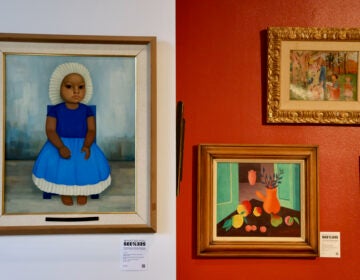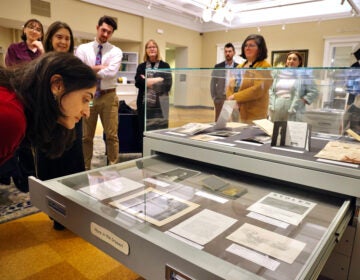Jayson Musson explains art history as a sitcom at Philly’s Fabric Workshop and Museum
“His History of Art” at the Fabric Workshop and Museum traipses through history as a whimsical, crass TV show.

Jasson Musson sits on his ''Pieta'' chair on a stage set filled with art allusions and an animatronic puppet named Ollie. The set was used to create Musson's satiric art history videos. (Emma Lee/WHYY)
“I have one foot in pop culture, and one foot in ideas around art,” said Jayson Musson on the shooting set of his sitcom, “His History of Art.” “Elements of pop culture, I don’t find any less important than art.”
The show is not intended for broadcast or streaming, but is the result of the Philadelphia-based artist’s residency at the Fabric Workshop and Museum, where he worked with the staff to conceive, fabricate, and shoot three short episodes of “His History.”
The episodes, each roughly 10 minutes long, are now screening in the gallery of the Fabric Workshop as part of Musson’s first museum solo exhibition, “Jayson Musson: His History of Art.”
“His History” stars Musson as Jay, a somewhat pompous art collector who lives with Ollie, a crass rabbit puppet who has matted, dirty fur akin to Sesame Street’s Oscar the Grouch. Ollie is voiced and puppeteered by Cedwan Hooks.

“Ollie doesn’t care about a lick of history or art history,” said Musson. “He cares about the things he views through the lens of his phone and social media. He’s a person of his world, essentially, the conditions of the world.”
As Jay tries to enlighten Ollie about the importance of arts throughout history, we see that Jay has his own flaws.
“He’s very insulting to Ollie. He’s condescending,” said Musson. “Sometimes that’s how people come off when they want to educate other people.”
Musson has created the necessary ingredients for a typical sitcom: personalities clash, hijinks ensue, and by the end, somebody learns a lesson.

Musson said he took cues from “The Mighty Boosh,” a British comedy troupe that had a show on the BBC from 2004-2007, and the American sitcom “Frasier” in which Kelsey Grammar and John Mahoney played a sparring father and son with polar opposite cultural tastes.
Revealing the depth of Musson’s art history background, he is also riffing on “How to Explain Pictures to a Dead Hare,” a 1965 performance art piece by the German artist Joseph Beuys.
The apartment shared by Jay and Ollie exists out of linear time and space. It is a white cube crammed with well-known pieces of art reimagined by Musson and the Fabric Workshop team: the melting clocks of Salvador Dali’s “Persistence of Memory” becomes a tufted throw rug, Andres Serrano’s controversial “Piss Christ” photo is a tabletop fish aquarium, Anish Kapoor’s monumental stainless steel “Cloud Gate” sculpture in Chicago’s Millennium Park is reduced to a shiny paperweight.
Seemingly out of character with the rest of the set, there is also a prop from Star Wars: the mask Princess Leia wore to disguise herself as the bounty hunter Boushh to rescue Han Solo from Jabba the Hutt in “Return of the Jedi.”
Musson said the Star Wars mask is for himself.
“That’s a Jayson thing,” he said. “Jay doesn’t know.”

On the back wall is a black door painted with nested white pinstripes to resemble Frank Stella’s “The Marriage of Reason and Squalor.” Similar to the land of make-believe in “Mr. Roger’s Neighborhood” the door acts as a magical portal to historical eras that enable Jay to give Ollie lessons in art history.
The show is both informed by and critical of art history. The first episode is a cautionary tale of leveraging artistic iconography to establish religious and political power. The second episode brings to life the prehistoric figurine, “Venus of Willendorf,” likely representing a fertility goddess carved from limestone in about 27,500 BCE.

“What I would love for our visitors to walk away with is to understand how art history is history,” said Fabric Workshop and Museum executive director Christina Vassallo. “It is the visual reflection of what’s actually happening in the world at that time. Ollie the character understands that his obsession with online notoriety and popularity really has art-historical precedent to it.”
The show has the clunkiness of a television sitcom. The lines sometimes ring hollow, and an inserted laugh track jolts the senses. This is intentional.
“The laugh track is there to annoy smart, art-loving people,” said Musson. “They’re so smart they don’t want to be told when to laugh. It’s something that I really enjoy, but I know that certain people with certain dispositions will be like, ‘Oh, philistine.’ Screw them.”

Musson has a history of performance in his art practice. He was in the hip hop group Plastic Little (“Technically I’m still in the band, it still exists although we haven’t played a show in years.”) and became well known in 2010 for “ART THOUGHTZ,” a series of talking head YouTube videos wherein he played a character named Hennessey Youngman critiquing the art world.
Musson said he had given up performance after ART THOUGHTZ, preferring instead to make work without putting himself at the center of attention. He briefly relocated to New York, then returned to Philadelphia a few years ago. In 2014 one of his abstract paintings was acquired by the Philadelphia Museum of Art: “Trying to find our spot off in that light, light off in that spot.”
As “His History” evolved over the course of the artist residency, he was drawn back into playing a character. What he said had started out as a nascent concept to revisit Hennessy Youngman “with a budget,” ultimately evolved into a different character, a different concept, and a fully realized visual world.

One of the founding programs of the Fabric Workshop and Museum is its artist residency, where an artist is invited to experiment with the organization’s fabrication equipment and staff expertise to conceive and create something new.
The residency is meant to encourage artists to take risks and evolve their work in an unexpected direction. Vassallo calls it the “FWM moment.”
“We know that when artists experiment and collaborate with us, they’re going to walk away looking at their work in a fresh light with a new perspective,” she said. “We like to track how that new perspective develops over time. That’s the FWM moment: Where are the experiments that they did with us showing up later in their career?”

The three episodes of “His History” are the main part of the Fabric Workshop exhibition, which also has on display the shooting set. An animatronic Ollie puppet is seated on a ratty couch, activated by “smart” sensory triggers that can detect the number of visitors in the room and their movement. He is programmed to turn his head to watch people walk past, occasionally offering snarky comments.
Behind the set is another gallery showing the process by which the Fabric Workshop fabricated the various items in the show.
“Jayson Musson: His History of Art” will be on view at the Fabric Workshop and Museum until November 13.
WHYY is your source for fact-based, in-depth journalism and information. As a nonprofit organization, we rely on financial support from readers like you. Please give today.







